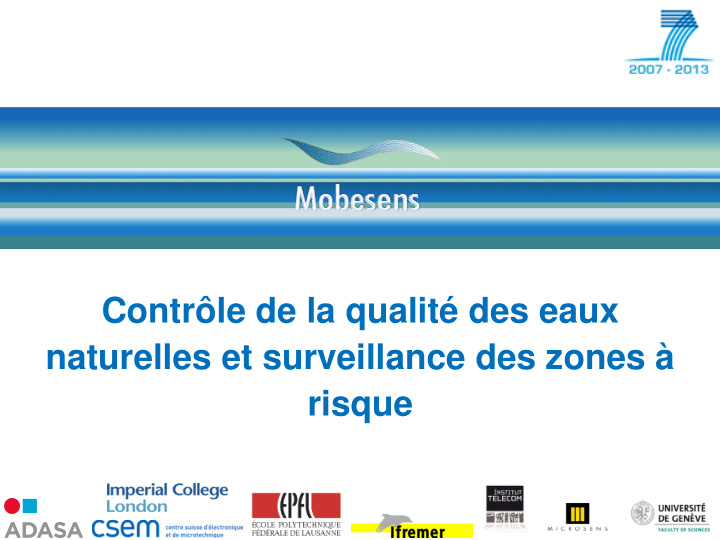



Contrôle de la qualité des eaux naturelles et surveillance des zones à risque
Table of content • The Mobesens concept • Examples from deployments • Sensor, Measurements and communication !
The Mobesens concept MOBESENS is a research initiative to develop a beyond the State of the Art Ecological, Open, Modular and Scalable ICT based solution for 'always on' and 3D water quality monitoring. Grid Wireless Sensor Network Gateway Internet
Different level of work • High level of research • Inertial Pendulum • Electrical tuning of harvester • Energy Transfer • Micro Acoustic sensor • Polymer Brushes • High level of availability • Wireless Sensor Nodes • pH ISFET • VIP • High level of development • Relative localization • Kayak • GRID
Sensors used in Mobesens Sensor probe Measuring GIME VIP Cd, Pb, Cu IsFET pH Non charged organic µ pollutant Micro Acoustic Sensor pH, K + (IsFET) Polymer Brushes on (sensors) + , PAH, pH (Acoustic) NH 4 Hg (GIME VIP) Mini multiparameter probes Conductivity, Temperature, Depth
Examples from Deployments • Ebro River • Long term • Thau and Vidy • Kayak mobility • Localisation
Ebro River deployment • Long term • Opportunistic download • Comparison
Ebro architecture The com m unication structure im plem ented during the Ebro in-field tests Tw o buoys w ith I SFET pH and T sensors, com m unication W iseNodes and energy system One drifter w ith I SFET pH and T sensor and com m unication nodes and energy system
Thau and Vidy Deployment • Technology evaluation • 3d screening
Deployment architecture Grid Wireless Sensor Network Gateway Internet
VIP Profiling from kayak and boat • 3D Screening of master variables using the multiparameter probes: • Profiling of T, pH, O 2 , conductivity, salinity, (chlorophyll a) at up to 22 stations in an area of typically 1 km2 in few hours • Outcome: • Efficient tracking under contrasting meterological conditions of: ü the spreading of an effluent release from anthropogenic activities in coastal area ü and its impact on the physico- chemical conditions of the media • via ü 3D visualization of conductivity data ü intercomparison of the master variable profiles
VIP Profiling from kayak and boat • Bioavalaible metal species measurements with the GIME-VIP voltammetric probes • Profiling in selected stations which may be impacted by effluent release from natural or anthropogenic sources (i.e. identified from the VIP multiprameter probe screening of mater variables from a boat or the drone) • Outcome: • Efficient tracking of the input of heavy metals and change in the concentration of their more toxic fraction : ü Intercomparison of bioavailable metal concentrations monitored in mass water impacted or not by the effluent release Station MOBESENS 1 Station MOBESENS 1 Station MOBESENS 2 Station MOBESENS 2 (Vidy Bay 14.10.2011) (Vidy Bay 14.10.2011) (Vidy Bay 19.10.2011) (Vidy Bay 19.10.2011) 10 m 10 m 10 m 10 m 400 400 450 450 500 500 550 550 500 500 500 500 450 450 450 450 20 m 20 m 21 m 21 m 400 400 400 400 350 350 350 350 400 400 450 450 500 500 550 550 400 400 450 450 500 500 550 550 500 500 500 500 450 450 450 450 28 m 28 m 26 m 26 m 400 400 400 400 350 350 350 350 400 400 450 450 500 500 550 550
Outcome for policy maker • I ntercom parison dynam ic vs total, total dissolved m etal concentrations • Outcom e: • Reliable m onitoring of the dynam ic ( i.e. bioavailable) Me fraction is required for a m ore rigourous assessm ent of the potential ( eco) toxicity im pact of m etal released ü Proportion of the dynamic metal species may change significantly: ü from one metal to an another (due to significant difference in metal sorption properties) ü from a given water composition to an another (i.e. metal sorption properties are function of the physico-chemical conditions and composition of the media Exam ple of trace m etal speciation m onitored in the Vidy Bay and Thau Lagoon Cd Cd Pb Pb Cu Cu 3 3 20 20 35 35 36 36 41 41 Weather station Weather station 65 65 64 64 38 38 3 3 17 17 25 25 43 43 45 45 Freshwater sink Freshwater sink 57 57 72 72 38 38 20 20 40 40 Industrial area Industrial area 40 40 % VIP Me dyn % VIP Me dyn % Me coll % Me coll % Me part % Me part
The research leading to these results has received funding from the European Community's Seventh Framework Programme (FP7/2007-2013) under grant agreement n° 223975 • Martin Sénéclauze, Coordinator • martin.seneclauze@csem.ch • +41 32 720 53 40
Recommend
More recommend